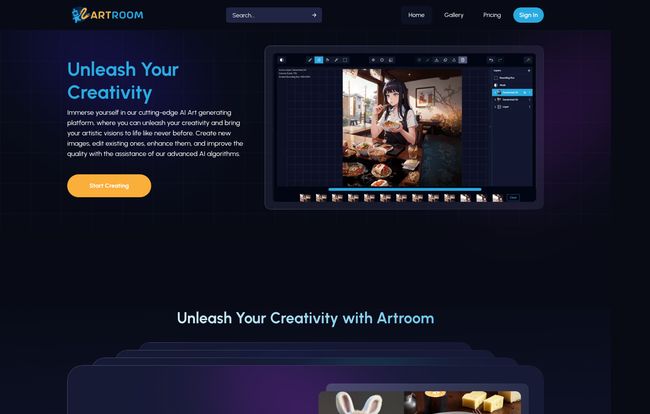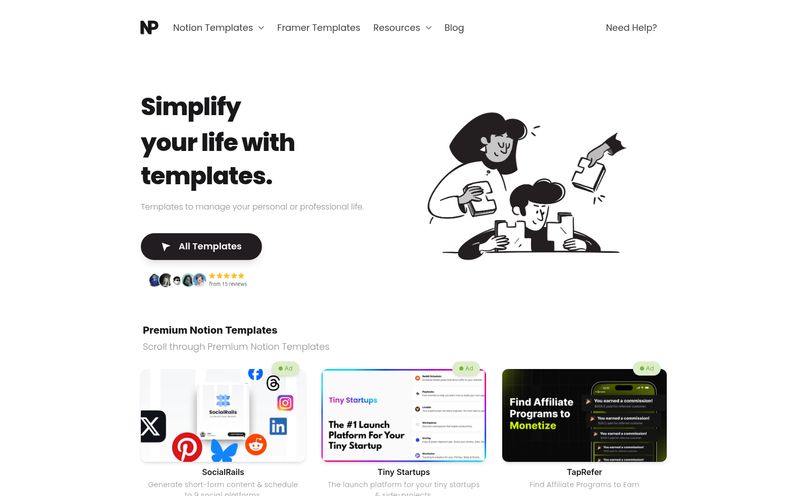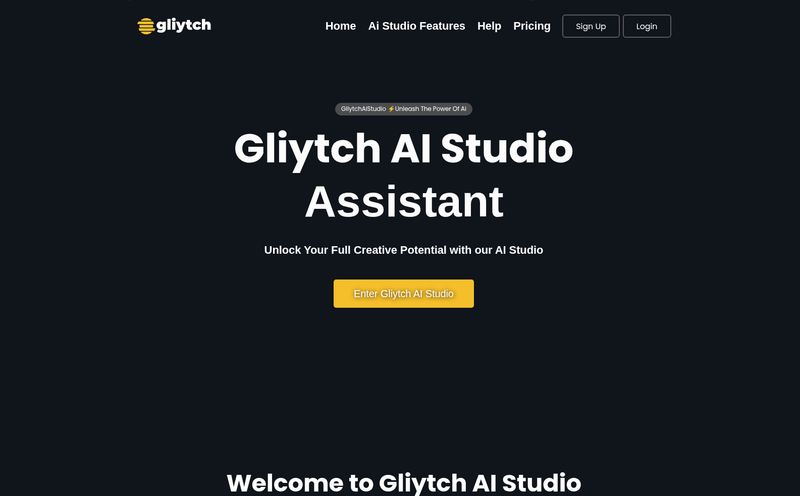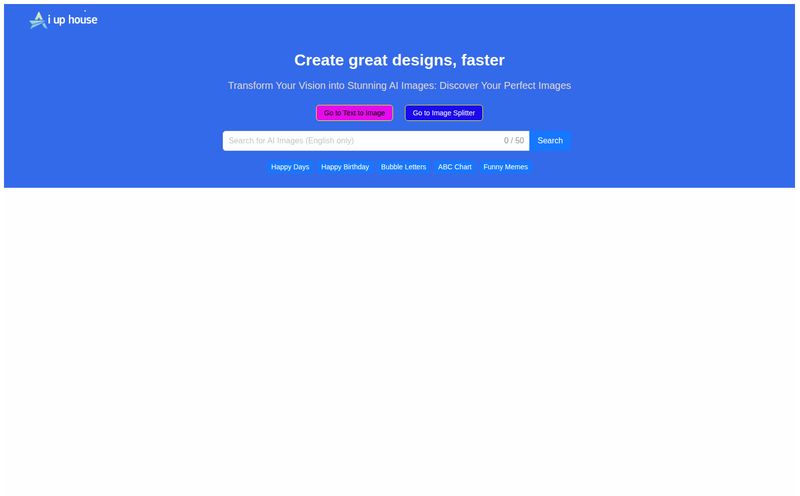If you're like me, your inbox and social feeds are probably overflowing with the "next big thing" in AI. Every week there's a new tool that promises to revolutionize... well, everything. And in the world of AI art, it's a full-on gold rush. I've been generating traffic and watching trends for years, and I've seen platforms come and go. Most are just slight variations of the same thing. A text box, a 'generate' button, and a prayer that you dont get a person with seven fingers.
So when I first heard about ArtRoom AI, I was skeptical. Another one? But I kept seeing mentions of it in some of the more niche creator communities, so I figured I had to give it a proper look. And honestly? I'm glad I did. This one feels a little different. It's less like a gumball machine for images and more like a proper digital art studio that just happens to have a very clever AI assistant.

Visit ArtRoom AI
So, What Exactly is ArtRoom AI?
At its core, ArtRoom AI is an AI art generation platform. You type in words, it spits out pictures. Simple enough. But that's where the similarities to some of the more basic tools end. Where ArtRoom starts to stand out is in its focus on control. This isn't just about rolling the dice on a prompt. It’s designed for people who want to create, edit, enhance, and really get their hands dirty in the creative process. Think of it as the midpoint between the dead-simple prompt-based generators and a full-blown program like Photoshop. It gives you the power of AI without completely taking the steering wheel from your hands.
My First Impressions and The User Experience
When you first land on the platform, it feels clean. It's not intimidating. Some of these AI tools look like they were designed by engineers for engineers, you know? A mess of sliders and options with no clear starting point. ArtRoom avoids that. The layout is intuitive, guiding you toward creating without making you feel like you need a PhD in machine learning to get started.
It feels like it was designed with an artist's workflow in mind. You can generate a base image, and then immediately start working with it, adding layers, making tweaks, and running it through another AI process. It's a much more iterative and natural way to create, in my opinion.
The Features That Actually Matter
Look, any tool can list a dozen features on its homepage. But which ones will you actually use? After spending some time with it, a few things really jumped out at me as genuine game-changers for anyone serious about AI art.
Beyond Basic Prompts: ControlNet and Loras Are Here
This is the big one. If you've been in the AI art space for more than five minutes, you've heard of ControlNet and Loras. They're what separate the hobbyists from the pros. In simple terms, ControlNet lets you guide the AI's composition using a source image—like a stick figure pose, a line drawing, or a depth map. You're not just telling the AI what to draw, but how to draw it. Total control over character poses. It's huge.
And Loras? They're like little style packs. You can train them on a specific character, art style, or concept and then apply them to your generations with a click. ArtRoom AI offers unlimited Loras and, this is the kicker, it has a direct integration with Civitai. For those who don't know, Civitai is the biggest hub for community-made models and Loras. Being able to pull from that library directly inside ArtRoom is just... chef's kiss. It saves so much time and hassle.
A Painter's Toolkit with Layers and Editing
I was genuinely surprised to see a full-service painting system with layers. This means you can generate an initial concept, then add a new layer to paint in some adjustments, maybe remove an awkward element with an eraser, and then feed that back into the AI for further refinement (a process often called img2img or inpainting). It’s a much more hands-on approach that I really appreciate. It makes you feel like a co-creator with the AI, not just a client ordering a commission.
Image Quality and Those Little Quirks
The results are high-quality, especially on the paid plans that use premium GPUs. But like all AI, it has its quirks. One thing I noticed, which the platform itself is refreshingly honest about, is that image quality can be best when the dimensions are closer to a square aspect ratio, like 512x512 or 1024x1024. When you push into wide or tall formats, you might see a bit more weirdness. This is a common Stable Diffusion issue, and the fact they're up-front about it is a good sign. It's a small tip, but it's the kind of insider knowledge that saves you a lot of frustration and wasted credits.
Let's Talk Money: ArtRoom AI Pricing
Okay, the all-important question: what's it going to cost? ArtRoom AI runs on a freemium model, with different tiers that offer more resources. The currency of the platform is "shards." Here’s a quick breakdown:
| Plan | Price | Key Features |
|---|---|---|
| Free | $0 / month | 120 shards/day, 100 MB storage. Great for trying it out. |
| Basic | $9 / month | 10,000 shards/month, 10GB storage, ControlNet, Unlimited Loras, up to 1K resolution. |
| Pro | $29 / month | 35,000 shards/month, 30GB storage, all Basic features, up to 2K resolution. |
| Premium | $59 / month | 80,000 shards/month, 100GB storage, all Pro features, up to 4K resolution. |
My take? The Free plan is genuinely useful. 120 shards a day is enough to really play around and see if you like the workflow. The Basic plan at $9 is the sweet spot for serious hobbyists or creators just starting to monetize their work. The Pro and Premium plans are for power users and professionals who are generating tons of images and need higher resolutions and more storage. It's a pretty fair and standard pricing structure for the value you're getting, especially with the ControlNet and Lora features.
The Good, The Bad, and The Arty
No tool is perfect. Let's be real. On the plus side, the user-friendly interface is a huge win. The level of control with advanced features is fantastic, and that Civitai integration is a massive time-saver. I also appreciate their apparent support for model creators and a more ethical approach to AI.
On the flip side, you'll need to pay to get the most out of it. The free plan is great, but for any serious volume of work, you'll hit that shard limit. The strict no-NSFW policy is standard for most major platforms but could be a drawback for some artists. And as mentioned, you have to be mindful of your image dimensions to get the absolute best quality, which requires a bit of a learning curve.
Frequently Asked Questions about ArtRoom AI
Who actually owns the images I make?
This is a big one in the AI world! Based on their terms and the standard industry practice, you generally own the images you create. You can use them for personal or commercial projects. It’s always a good idea to double-check the platform's latest Terms of Service, but they're built to be a tool for creators, so ownership is typically with you.
Can I make NSFW images?
Nope. The platform is pretty clear on this. Like many mainstream AI services, they prohibit the generation of not-safe-for-work content. If that's your primary goal, you'll need to look at running a local version of Stable Diffusion on your own machine.
Why do I sometimes get weird results like double heads or extra limbs?
Ah, the classic AI nightmare fuel. This is a common problem with current AI image generation models, not just ArtRoom. It happens because the AI doesn't understand anatomy like a human does; it just understands patterns from its training data. Using ControlNet to guide the pose and adding negative prompts (e.g., "extra limbs, mutated hands") can significantly help reduce these kinds of errors.
Why can't I find a specific Lora from Civitai?
While the integration is great, it might not have every single Lora ever uploaded, especially brand new ones. There can be a slight delay in syncing, or certain types of Loras might not be compatible. However, the library available is massive and covers most of the popular and high-quality options.
How does ControlNet work, in simple terms?
Think of it like tracing paper for the AI. You give it a 'control' image, like a simple sketch of a person standing, a photo of a room, or even just colored blobs. The AI then uses that image as a strict guide for the structure of the new image it creates based on your text prompt. So your prompt provides the 'what' (a knight in shiny armor) and the ControlNet image provides the 'how' (standing in this exact pose).
My Final Verdict on ArtRoom AI
So, is ArtRoom AI just another flash in the pan? In my opinion, no. It has carved out a really smart niche for itself. It’s not for the person who wants to type three words and get a perfect, finished masterpiece in one shot. It's for the tinkerer, the artist, the creator who sees AI as a collaborator, not a vending machine.
If you've felt limited by simpler tools and want more control without the headache of setting up a local AI environment, I think ArtRoom AI is absolutely worth your time. The combination of a user-friendly interface with powerful features like ControlNet and direct Lora integration makes it a formidable and, more importantly, a genuinely useful tool in an increasingly crowded market. Give the free plan a spin—you might just find your new favorite creative partner.



